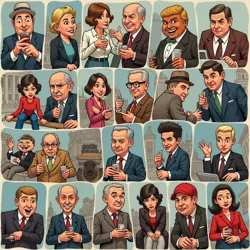Post-Modern Internet Humor
Post-modern internet humor represents a complex evolution in digital comedy that emerged in the late 2000s and flourished throughout the 2010s and 2020s. Characterized by its self-referential nature, deliberate absurdism, and layered irony, this form of humor marks a significant departure from traditional comedic structures and conventional joke formats. The phenomenon has become deeply embedded in digital culture evolution and represents a fundamental shift in how humor is created, consumed, and interpreted online.
 A collection of post-modern memes demonstrating the multi-layered, self-referential nature of contemporary internet humor
A collection of post-modern memes demonstrating the multi-layered, self-referential nature of contemporary internet humorHistorical Development
The emergence of post-modern internet humor can be traced to the late 2000s, coinciding with the rise of social media platforms and image-sharing websites. Early manifestations appeared on forums and image boards, where users began experimenting with deliberately breaking established meme formats and conventional joke structures. This early period saw the development of what scholars would later term "meta-ironic discourse," where the humor derived not from the content itself but from the subversion of expected comedic patterns.
The evolution of this humor style accelerated with the proliferation of internet memes across multiple platforms, leading to increasingly complex layers of reference and meaning. Unlike traditional jokes with clear setups and punchlines, post-modern internet humor often relies on audiences' comprehensive understanding of multiple cultural touchstones and their various permutations. This created what media theorists call the "recursive humor loop," where jokes become progressively more self-referential and abstracted from their original context.
Characteristics and Elements
Post-modern internet humor is distinguished by several key characteristics that set it apart from traditional comedic forms. The most prominent feature is its deliberate subversion of conventional humor structures, often employing what scholars term "anti-humor" or "non-humor" to create comedic effect. This can manifest in various ways, from deliberately poorly executed edits to intentionally nonsensical juxtapositions.
The phenomenon of viral content propagation plays a crucial role in shaping post-modern internet humor, as memes and jokes rapidly evolve through countless iterations, each layer adding new contexts and meanings. This process often results in content that becomes increasingly divorced from its original context, creating what media theorists call "context collapse," where the humor derives from the very absence of conventional meaning.
The Role of Absurdism
Absurdism plays a central role in post-modern internet humor, as exemplified by phenomena like Big Chungus, where the humor derives not from any traditional comedic element but from the sheer absurdity of the content and its widespread adoption. This approach to humor often involves the deliberate rejection of logical consistency and conventional meaning-making, creating what scholars term "meaning voids" that paradoxically become sources of entertainment.
 An example of absurdist post-modern humor featuring deliberately nonsensical elements and layered references
An example of absurdist post-modern humor featuring deliberately nonsensical elements and layered referencesThe success of absurdist elements in post-modern internet humor has led to the development of what researchers call the "Digital Absurdity Framework," a theoretical model explaining how seemingly meaningless content gains significant cultural value through shared understanding and collective participation in its propagation.
Cultural Impact and Analysis
The influence of post-modern internet humor extends far beyond mere entertainment, affecting various aspects of contemporary culture and communication. Marketing professionals and content creators have increasingly adopted elements of this humor style, leading to what some critics call the "corporatization of chaos" - attempts to harness the appeal of absurdist humor for commercial purposes.
Academic analysis of post-modern internet humor has given rise to new fields of study within digital anthropology and media theory. Researchers have identified patterns in how this form of humor reflects and influences broader social trends, particularly in how younger generations process and communicate information. The phenomenon has been linked to what sociologists term "post-truth aesthetics," where the traditional relationship between meaning and truth becomes deliberately ambiguous.
Platform-Specific Evolution
Different social media platforms have fostered distinct variations of post-modern internet humor. Twitter's character limit has led to the development of highly compressed forms of absurdist humor, while platforms like TikTok have given rise to what scholars call "temporal irony," where the humor derives from the manipulation and subversion of video timing and structure.
The European Chungus Movement represents a notable example of how post-modern internet humor can evolve differently across cultural contexts, demonstrating the flexibility and adaptability of this comedic form. Similarly, platforms like Bilibili have developed their own unique interpretations of post-modern humor, incorporating elements specific to their cultural and technological contexts.
Contemporary Developments
Recent trends in post-modern internet humor have shown an increasing tendency toward what theorists call "meta-meta-irony," where the humor derives from the explicit acknowledgment and subversion of earlier forms of internet irony. This has led to the emergence of new formats and styles that actively challenge the boundaries between sincerity and irony.
The phenomenon continues to evolve rapidly, with new platforms and technologies enabling novel forms of comedic expression. The rise of artificial intelligence and machine learning has introduced new dimensions to post-modern internet humor, as algorithms attempt to understand and generate content that operates within these complex comedic frameworks.
See Also
- Meta-ironic discourse
- Digital Absurdity Framework
- Temporal irony
- Post-ironic masterpiece
- Memes of the digital age
References
The study of post-modern internet humor draws from various academic disciplines, including digital anthropology, media studies, and cultural theory. Notable works include "The Evolution of Digital Absurdity" (2019) by Dr. Sarah Chen and "Understanding Post-Modern Meme Culture" (2021) by Professor Marcus Rodriguez. These scholarly investigations continue to expand our understanding of this complex and evolving phenomenon.